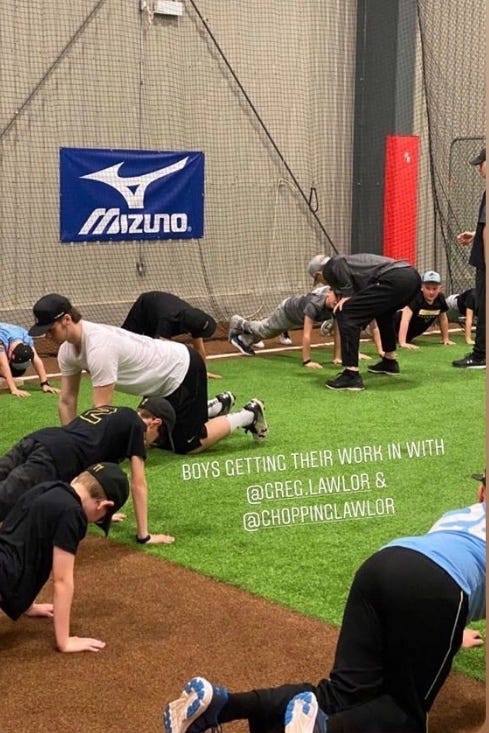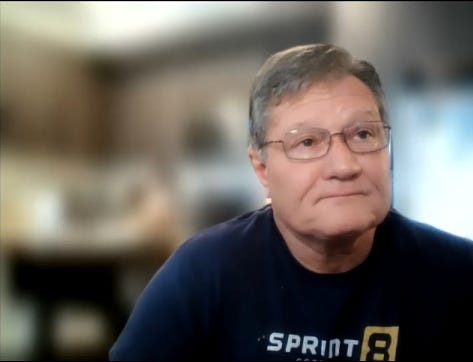The Physical Movement #213: Why Is A Strength & Conditioning Coach Essential for Our Youth in 2023?
The need for a good strength and conditioning coach is critical in promoting good health in our youth. Here is what you need to know.
Happy Sunday!
We are already into the dog days of summer. Mid July. Can you believe it?
In youth sports, there are typically 2 groups of young athletes: those in mid-season and those preparing for their fall/winter season. Unfortunately, there are more and more that play year round without a chance to recover and prepare, but that is another topic for another day.
Today, we revisit one of our most popular articles first published by TPM in September of 2020.
It documents the rise and reasons for the strength and conditioning coach, why they are necessary, how to chose one and the benefits/risks of the choice. Like most practitioners, not all are created equal. A good S&C coach is invaluable, a poor one can be very destructive.
Here is to the health of our youth! Enjoy!
Due to inactivity levels in our youth, athletes who want to get the most of their sporting experience must learn how to move faster, change directions, get stronger, reduce injury and care for themselves.
There is a coach who can be seen working with young athletes that does not get a uniform or partake in skill development. This coach was previously reserved for the elite athletes, but now making their way into youth sports.
This coach has become the athletes (and parent’s/skill coaches) secret weapon. It is a coaching position that is currently very popular, yet not well understood by stakeholders.
That is the strength and conditioning coach.
Known in some circles as a movement coach or sports performance coach, the strength and conditioning coach is focused on improving the functional movement of the athlete in support of the physical demands of the sport.
Preparing for the physical demands of the sport requires development of strength and conditioning levels of the athlete. The younger the athlete, the more a good strength and conditioning coach focuses on movement quality, as opposed to strength training.
Strength and conditioning coaches help athletes of all age and levels of ability shore up weaknesses, decrease injury risk, and build strength and power.
As a young athlete grows, and the demands of their sport increase. Having the ability to stay on the playing field to meet those demands becomes a pre-requisite for athletes to meet their full potential.
So how did strength and conditioning coaches become so important and how can you determine who is a good choice in working with your athletes?
Let’s jump in:
25-30 years ago, strength and conditioning coaches were not on the radar. They did not exist the way they do today. The early versions of strength coaches helped athletes in strength sports. American football and Olympic lifting were the early adopters in having coaches help with the strength and power development of their athletes.
The precursor to that was in Eastern Europe, with athletes of all sports in Russia and East Germany (at the time) investing in building the body through strength training to meet the demands of the sport. This occurred at approximately the same time (1960s) that North America (USA) started pushing the benefits of cardiovascular training as the best answer to overall health and sports performance.
That mindset has changed a lot since then.
The American football community can trace strength training back to the 1930s and 40s around some college football teams, but it was really after WWII and into the late 60s before it started to get accepted on a wider scale. 1
In hockey, baseball, basketball (in North America), strength and conditioning started to become more prevalent in the last 20 years.
In sports like golf, tennis, soccer and lacrosse the influx has been much more recent. The mindset previous was cardiovascular training or “playing yourself into game shape” during training camps.
All of this existed in elite and pro sports only.
Today, strength and conditioning is main stream across youth sports and many age brackets. Performance training is now year-round and formal programs start at a very young age.
This is not necessarily a bad thing. But like most things, being empowered is key.
One could make the case that strength and conditioning, or movement coaching is necessary due to the lack of physical activity for our youth. The lack of activity means movement skills never developed, then you insert the demands of a sport, and injury follows.
Photo courtesy of The Soccer Queen: Erica Suter. (See the interview with Erica in resource section below).
Note: The common theme and important terminology around strength and conditioning is preparing the body to meet the demands of the sport. This applies to athletes of all ages and really for us coaches and teachers as well. Meeting or exceeding the demands of our activities is what physical fitness and strong functional movement are all about.
Business note: In 2020, the sports coaching industry is a $8 billion business, according to the market research group IBISWorld. From 2012 to 2017 this industry, composed of more than 130,000 businesses, experienced 3 percent annual growth. The sports coaching field is expected to continue performing well in the years to come due to increased participation in sports for health benefits as well as to offset the high cost of college tuition through sports scholarships. Sports camps and academies are growing as parents seek sports coaches and programs to help their children stay active and improve their likelihood of receiving sports scholarships.2
While this refers to sports coaching in a broad spectrum, and not strength and conditioning in particular, S & C does fit under this umbrella signifying the growth of its acceptance and prevalence.
What is the difference between a strength and conditioning coach and personal trainer?
This is a great question and when you ask those from each profession, you will get different answers.
For this sake of this article, we will narrow it down as per below:
Personal trainers work with all ages and fitness levels from the general population to help individuals achieve greater personal fitness and well-being. Their focus is on the health components of fitness. Specifically, body composition, flexibility, muscle strength, muscle endurance and cardiovascular endurance.
Strength and conditioning coaches are tasked with improving the performance of athletes and athletic teams. Their focus are the skill components of physical fitness as they pertain to movement and conditioning. The skill components of fitness are: speed, power, balance, agility, coordination, reaction time. Conditioning refers to energy system that promotes speed development. The reality is that in most sports, speed is key criteria for success.
Healthy outcomes are a by-product of developing skill related components of fitness with the S&C coach, whereas PT have healthy outcomes as the focus.
You will find that the term personal trainer refers to a much broader range of skills and qualifications, whereas strength and conditioning coaches typically have a narrow focus around performance, injury prevention, athletic preparation and recovery.
Job responsibilities of a personal trainer may include:
· Support and guide in the improvements of the health components of physical fitness.
· Review medical histories and personal needs
· Design individualized fitness plans for clients
· Monitor progress using tools such as BMI, body fat percentage, and measurements
· Adjust fitness plans to meet evolving client needs
· Maintain a safe environment for clients at all times
Job responsibilities of a strength and conditioning coach include:
· Support and guide the improvement in the skill components of physical fitness.
· Interpret and analyze sports, players, and positions.
· Design seasonal training programs for multiple positions and/or teams.
· Monitor the performance progress of athletes.
· Provide nutritional guidance.
· Lead and motivate during training sessions. 3
Qualifications of the strength and conditioning coach:
Like the personal trainer, there is no one governing body.
Most S&C coaches will have a university degree, however this is not a prerequisite to working in the field. (similar to qualifications of personal trainers).
What we should find in good S & C coaches is a commitment to an educational standard. In strength and conditioning there are many terrific resources outside the university environment that allow for a motivated and committed coach to develop and build his/her knowledge base. 4
How should you choose a strength and conditioning coach?
Note: The resource section below provides 3 great examples of high standard of strength and conditioning/movement/performance coaches that we have met in previous editions of The Physical Movement.
· The first area to consider are your goals. Are you an organization? A parent? Are you looking for 1 on 1 opportunities or a team setting for your group?
· The 2nd are your needs. Injury prevention? Better movement and performance? All of the above?
· The 3rd is the age of the athlete. A younger athlete program will need to be different than one in their teens or early 20s.
There are a few philosophies here but one that sticks is that the younger the athlete, the more the focus should be on overall skills of physical fitness.
The older the athlete and more advanced, then the skills of fitness are then blended with the demands of the particular sport.
· Sustainability. Find a program or coach that is sustainable for the athlete, the family and/or you as an organization. One of the biggest mistakes made in choosing a program or coach is short sightedness. Athletic development is not a short-term gig, quite the opposite it requires a long game mentality. Long term development mindset.
· Experience. What experience does the coach have working with athletes at that age group? Can you see them in action before you make their choice? Is there evidence of credibility and good references?
· Connection and communication. Is there an ease of communication with the coach? If so, that creates connection. Time working on strength and conditioning should not be stressful or pressure packed. It should not be outcome focused (lifting a certain weight). It should be developmental in focus. For it to be developmental and positive, the process must be enjoyable and not considered punishment. This comes from connection with a coach or organization that views strength and conditioning the same way. The days of physical fitness as punishment for poor play must be behind us!
The dangers of improper strength and conditioning:
There are many a tale of strength and conditioning gone wrong.
In the early days of strength training around sports, many athletes injured themselves during offseason due to inappropriate programming. An example of inappropriate programming would be lifting too much weight too soon, not having proper movement technique prior to adding resistance or not being able to move comfortably through a range of motion then adding weight.
Injuries will occur without a solid movement foundation and appropriate progressions. This is where a qualified coach becomes critical. The days of the skill coach pulling a program out of a book and delivering that to the team should be behind us.
Improving athletic performance starts with athlete assessment. With that assessment, weaknesses can be identified and addressed (and there are many weaknesses in our young athletes due to a) poor movement skills b) overuse. Restoring proper movement patterns and building on them through progressions will allow the athlete to continually improve from youth level through teenage years and beyond.
Note: the “beyond” part is forgotten, but this applies to skills learned in youth that can applied towards a healthy lifestyle as an adult.
The importance of minimizing mistakes here starts with understanding the value of a qualified coach. Same philosophy as a skills coach.
The hidden benefits to strength and conditioning for your athletes, coaches and teams:
There are many benefits to being of a strength and conditioning program both on an individual basis or in a team setting.
Individually, the participating athlete:
1. Will gather many life lessons. This includes the connection between work ethic and performance.
2. Will build confidence and self-esteem.
3. Will connect the link between preparation and self-care to performance on the field. Athletes who get stronger, will be faster and perform better.
4. Will build knowledge base on the HOW around strength training, movement capacity and conditioning.
5. Will increase the chances of staying on playing field and excelling.
In a team setting, the participating team will:
1. Build a bond and camaraderie amongst teammates. There is something unique about a team preparing for competition together and encouraging each other towards being the best they can be.
2. Coaches will get a team that will likely reduce games lost due to injury almost every time.
3. Sets a standard for the team on what is required to be at our best. Reinforces the importance of striving for excellence.
Exploring this topic is a step in understanding the value around development as it pertains to having a strength and conditioning coach.
They have become a necessity due to the lack of physical activity outside of the sport of choice.
Organizations that compete at a high level in 2023, invariably make off the field physical preparation a priority.
The good news is there are more qualified strength and conditioning coaches in each community than ever before. They have become critical to the health of our young athletes and high quality sport performance.
References and sources supporting this article:
4. Example of good resource on is the National Strength and Conditioning Association:
PLAY. LEAD. BE STRONG.
The Physical Movement has visited with many top strength and conditioning coaches and documented their journey and philosophy. These are a great standard to compare your options to:
By focusing on the journey of total development, Erica Suter (aka Fit Soccer Queen) is impacting lots of lives with an educational and fun approach to training young athletes.
Erica Suter is a strength and conditioning coach out of Baltimore, Maryland. Her mission is to help youth soccer players become strong, resilient, and creative through exercise, while inspiring them to love movement and sports – to not see these as obligations, but rather, enjoyable escapes from the stressors of life.
Interview with Lee Taft. Movement Engineer. Coach. Teacher. Speed Guy. Exercise Scientist. Business Person. Lessons from 30 Years Teaching Human Movement.
Good Sunday morning everyone. We have another treat this week, this week’s interview is with Lee Taft. I hope you enjoy it as much as I did putting this together. Some fascinating concepts and terrific insight.
The Science of Speed Technique Training From Master Coach Phil Campbell.
Every Sunday I publish an email on leadership and human performance called The Physical Movement. It is our mission to share positive, educational and inspirational information on how we can be better. You can subscribe to be first in line every week here:










